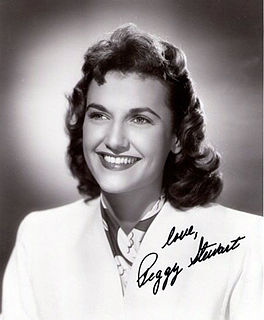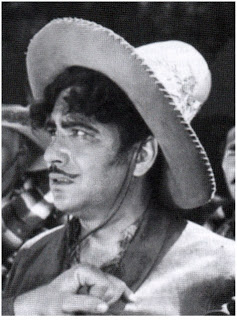
Frank O'Connor was an American character actor and director, whose career spanned five decades and included appearances in over 600 films and television shows. Early in his career he was also billed as Frank A. Connor and Frank L.A. O'Connor. During the silent film era, he directed or was the assistant director on numerous films; he also penned several screenplays in both the silent and sound film eras. He is sometimes erroneously identified with the Frank O'Connor who was married to author Ayn Rand.

Peggy Stewart was an American actress known for her roles in Western B movies and television series.

Almira Sessions was an American character actress of stage, screen and television. Born in Washington, D.C., her career took her through all the acting mediums of the 20th century. She appeared in over 500 films and television shows. She worked into her 80s, finally retiring shortly before her death in 1974 in Los Angeles.

Frank Marlowe, also known as Frank Riggi and Frank Marlo was an American character actor from the 1930s until the 1960s. During Marlowe's 30-year career he would appear in over 200 feature films, as well as dozens of television shows.

Ted Mapes was an American character actor, who was also a prolific stuntman and body double. Born on November 25, 1901 in St. Edward, Nebraska, he moved to Los Angeles in his mid-20s, and entered the film industry in 1929, first as a grip, and then as a stuntman and actor. He doubled for many famous actors, including Jimmy Stewart and Gary Cooper. His film and television career spanned forty years, during which time he appeared in hundreds of films and television shows, either as an actor, stuntman or body double. After his career in front of the camera ended in 1969, Mapes became an advocate for animal safety in films, working as an observer on sets for the American Humane Association.

Eugene Borden was an American character actor in silent and sound films. Born in France, he immigrated to the United States as a teenager, and entered the film industry a short time later. He appeared in over 150 films, as well as shorts, serials, and television shows.
John F. Link Sr. was an American film editor from the 1930s through the 1960s. Born in Alabama on March 22, 1901, he began editing in 1930. He began editing film shorts, and from 1930-32 he edited almost 20. Link was given his first opportunity to edit a feature film in 1932, with Carnival Boat, directed by Albert Rogell, and starring Bill Boyd and Ginger Rogers. In his 30-year career, he would edit over 30 films, with the highlight of his career would be the 1943 classic, For Whom the Bell Tolls, starring Gary Cooper and Ingrid Bergman. Link, along with co-editor Sherman Todd, received an Academy Award nomination for their work on this film.
Louis Stevens was an American screenwriter of the silent and sound film eras. Born on Christmas Day 1896 in Riga, Governorate of Livonia, Russian Empire, Stevens entered the film industry in 1920 when he co-wrote the silent film A World of Folly, with Jane Grogan. In his over 30-year career he worked on over 40 screenplays, as well as several film shorts and two television series. Among his more notable films were: contributing to the script of the 1931 version of Dracula, starring Bela Lugosi; co-writing the story for What Price Hollywood? (1932); the screenplay for the 1940 western, Colorado, directed by Joseph Kane, and starring Roy Rogers; the story for Streets of Laredo (1949), starring William Holden, Macdonald Carey and William Bendix; 1951's The Cimarron Kid, starring Audie Murphy; and Horizons West (1952), starring Robert Ryan, Julie Adams, and Rock Hudson. Stevens' final screenplay was for Flaming Frontier in 1958, although he did some work on additional dialogue for the 1959 film, Desert Desperadoes. Stevens also wrote several television episodes, one for Cheyenne, and two for Hawkeye and the Last of the Mohicans, all in 1957.
Harry Bowen was an American character actor of the silent and sound film eras. Born on October 4, 1888, in Brooklyn, New York, he broke into the film industry doing film shorts during the silent era. His work on shorts continued into talking pictures, and it was in 1929 that he made his first appearance in a full-length feature, with a small role in Red Hot Rhythm, directed by Leo McCarey. During his 20-year career, Bowen appeared in over 150 films, most of them film shorts. Other notable films in which he appeared include: the 1933 classic King Kong; Flying Down to Rio (1933), which was the first on-screen pairing of Fred Astaire and Ginger Rogers; John Ford's 1935 comedy, The Whole Town's Talking, starring Edward G. Robinson; and Next Time We Love (1936), starring Margaret Sullavan, James Stewart, and Ray Milland. His final screen performance, according to AFI, was the 1939 film, The Day the Bookies Wept, starring Joe Penner and Betty Grable.
Ben Markson was an American screenwriter active from the very beginning of the sound film era through the end of the 1950s. During his 30-year career he was responsible for the story and/or screenplay of 45 films, as well as writing the scripts for several episodic television shows in the 1950s.

John Hugh Elliott was an American actor who appeared on Broadway and in over 300 films during his career. He worked sporadically during the silent film era, but with the advent of sound his career took off, where he worked constantly for 25 years, finding a particular niche in "B" westerns.

John Melvin Bleifer was an American actor whose career began at the end of the silent film era, and lasted through the mid-1980s. He appeared in feature films and film serials, and in a number of television series and miniseries. Bleifer also acted on stage, and appeared in several Broadway productions.

Dick Botiller, sometimes credited as Richard Botiller, was an American character actor of the 1930s and 1940s. While most of his roles were un-credited, many of them nameless as well, he was given more substantial roles occasionally.

Claire Carleton was an American actress whose career spanned four decades from the 1930s through the 1960s. She appeared in over 100 films, the majority of them features, and on numerous television shows, including several recurring roles. In addition to her screen acting, she had a successful stage career.

George M. Carleton was an American character actor of the 1940s. He was a stage actor who began a brief career, during which he appeared in over 100 films, including features, film shorts, and film serials.

John L. Cason, also known as Bob Cason, was an American actor active in both films and television. During his 20 year career he appeared in over 200 films and television shows. He is best known for his work on the television program The Adventures of Kit Carson, where he appeared in several roles from 1951—53.

Harlan Briggs was an American actor and Vaudeville performer who was active from the 1930s until his death in 1952. During the course of his career he appeared on Broadway, in over 100 films, as well as appearing on television once towards the end of his career.
Harry Marker was an American Oscar-nominated film editor, who also worked in the television medium. Over the course of his 45-year career, he worked on more than 100 films and television shows. In 1946 he was nominated for an Oscar for Best Film Editing for The Bells of St. Mary's.

Edward Arthur Killy was an American director, assistant director and production manager in films and television. He was one of the few individuals to be nominated for the short-lived Academy Award for Best Assistant Director. During his 30-year career he worked on over 75 films and television shows.
Arthur T. Horman was an American screenwriter whose career spanned from the 1930s to the end of the 1950s. During that time he wrote the stories or screenplays for over 60 films, as well as writing several pieces for television during the 1950s.














